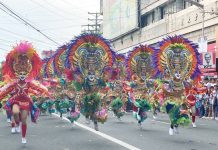
ILOILO City – In the thick of this metro’s morning bustle — where jeepneys cough through traffic and employees chatter on their way to work — two vendors quietly hold on to a tradition many have already forgotten.
On a street corner near a busy intersection, Jane, 39, sits beneath a worn umbrella with her modest display: a bundle of small Philippine flags, their red and blue slightly dulled by the sun.
A few meters away, Fred, 45, arranges his items on a low plastic table: flags, tote bags, and handmade pins in the colors of the republic.

Their stalls are humble, their presence easy to miss — but for Jane and Fred, these Independence Day rituals are nothing short of sacred.
“Before, there were flags on every street corner,” Jane says in Hiligaynon, adjusting the sticks so they stand proud against the light breeze. “Now, it feels like people have lost interest. Even on Freedom Day, they don’t seem to care anymore.”
For Jane, selling flags is more than just a way to earn. It is a tribute to the past, a thread that ties her to her family’s stories of struggle and resilience.
A mother of four, she recalls how her grandmother, a World War 2 survivor, used to speak of waving the flag as a powerful act of hope.
“The flag is not just for sale. It’s a reminder that people sacrificed so we could be here selling freely, choosing the lives we want,” she says. “Freedom, for me, is being able to choose the life I want — even if it’s hard, even if we’re poor — no one is stopping me from being a good mother, a strong woman.”
Fred, who has been in this trade just as long, shares her sentiment.
“For someone like me, freedom means not being afraid to make a living the way I want to,” he says, looking out at the passersby. “Even if I’m just selling flags or tote bags, no one tells me I can’t.”
He remembers the days when he worked three jobs to keep his children in school. For him, independence isn’t just about ceremonies or fireworks — it’s about survival, persistence, and dignity.
“If we didn’t have freedom, maybe we wouldn’t be here today. For me, independence isn’t just a word — it’s something we live out every day,” says Fred.
Yet every year, their task feels a little lonelier. Fewer people stop by. Fewer flags are bought. There are less signs of celebration on the streets.
But they’re not giving up.
“Even if only a few still buy, it’s okay,” Jane says with a gentle smile. “What’s important is that freedom is still here. The youth today might not be as expressive, but I believe they still love this country, even if quietly, in their own way.”
Fred nods as he watches a young boy pause to stare at the fluttering flags.
“Maybe that kid will ask his mother what these are for. And maybe that’s where understanding starts — when they begin to ask questions about their own freedom,” he says.
As June 12 rolls around again, amid the blare of vlogs and the rush of online sales, Jane and Fred remain small, steadfast beacons of patriotism. They may not draw crowds, but in their quiet dignity and unwavering belief, they keep the essence of Independence Day alive — one flag at a time.
FLAG DISPLAY
The national government is calling on all Filipinos to visibly demonstrate patriotism by displaying the Philippine flag from May 28 to June 12, as part of an extended celebration of National Flag Days leading to the country’s Independence Day.
Government agencies, schools, local government units, private institutions, and households are urged to participate in the tradition, which honors the national flag as a powerful symbol of the country’s sovereignty, history, and unity.
The observance traces its roots to Presidential Proclamation No. 374, issued on March 6, 1965, which declared May 28 as National Flag Day. This date marks the first unfurling of the Philippine flag after the Filipino victory against Spanish forces at the Battle of Alapan in 1898.
In 1994, Executive Order No. 79 expanded the commemoration to a 16-day period, culminating on June 12 — Philippine Independence Day — which celebrates the country’s declaration of freedom from Spanish colonial rule after more than three centuries.
In Western Visayas, all national and local government offices, government-owned and controlled corporations, and other institutions have been encouraged to lead in giving due respect to the flag. Civic groups and the business sector are likewise invited to join in the effort./PN



![FLOOD CONTROL SCANDAL: Ombudsman cases filed vs DPWH staff, contractors “This [flood control scheme] is a corruption on a scale that we have not seen in the past,” says Public Works Secretary Vince Dizon. “The Napoles scandal is like petty change compared to this.”](https://www.panaynews.net/wp-content/uploads/2025/09/Ombudsman_copy_resized-218x150.jpg)

